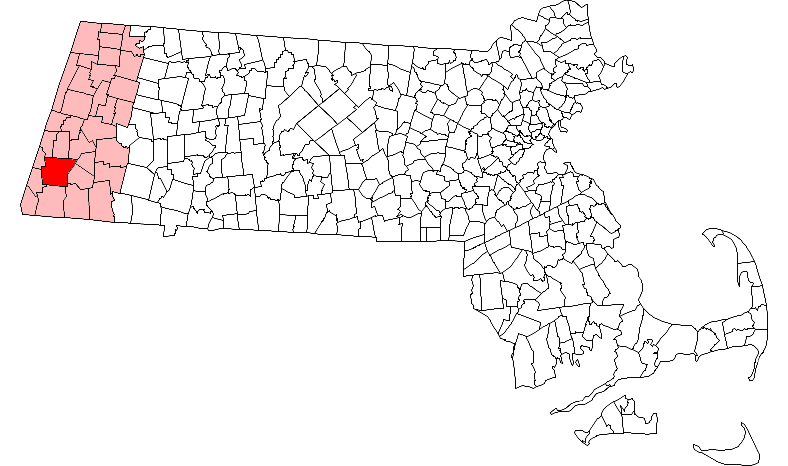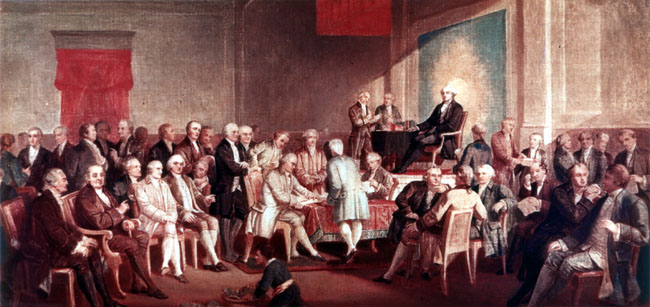Focus Question: Why was Shays’ Rebellion a crucial event leading to the Constitutional Convention?
*****Shays rebellion is especially important because it illustrates the weaknesses of the Articles of Confederation at that time.
It leads to the Constitutional Convention and eventually the ratification of the US Constitution*****


Topics on the Page
Overview
Background and Causes
Course of the Rebellion
Effects of the Rebellion
The Constitutional Convention
 Cross-Links
Cross-Links
Overview
For an overview, go to Shays' Rebellion & the Making of a Nation, a website developed by Springfield Technical Community College.
Click on this link for a short description of Daniel Shays and Shays’ Rebellion: which can be quickly summarized as an armed uprising by farmers in western Massachusetts that lasted from August of 1786 to June of 1787 against the government of that state.
Shays' Rebellion and Forty Acres, an overview from the Porter-Phelps-Huntington Museum (2021)
An 1826 map of Springfield, including the Armory

VIEWPOINTS
Shays' Rebellion: A Massachusetts Farmer's Account, Bill of Rights Institute
A Laborer Explains Shays Rebellion
George Washington Letter to Henry Lee (1786)
 VIDEO RESOURCES:
VIDEO RESOURCES:
https://www.youtube.com/watch?v=FeRYpVBWQN8
Click on the link above for a video that explains Shays' Rebellion in 1 minute!
https://www.youtube.com/watch?v=YOR9O9mUObE
View a 7 minute video from a history teacher who does a good job giving the viewer a basic understanding of Shays' Rebellion and the Articles of Confederation. This video includes a background of who Daniel Shays was and does a good job explaining the reasons why the Farmers took direct action against the State Government.
 Teaching and Learning Resources:
Teaching and Learning Resources:
Learning Plan: http://shaysrebellion.stcc.edu/shaysapp/lessons/lesson6.jsp
This is a great source for teachers who need help preparing for and teaching a lesson on Shays' Rebellion. It includes learning objectives, guiding concepts, preparation to teach the topic, and a lesson plan outline.
Learning Plan: https://mass.pbslearningmedia.org/resource/dpla-tg-028/teaching-guide-exploring-shays-rebellion/
This teaching guide offers discussion questions, classroom activities, and primary source analysis tools. It is intended to spark pedagogical creativity by giving a sample approach to the material. Press "launch" when you get to the page to see the material on Shays' Rebellion

Khan Academy's timeline of America's path to the U.S. Constitution and where Shay's Rebellion came into play.
An 1884 illustration from Harper’s Magazine, “Shays's mob in possession of a court-house.”

Background and Causes
After the America Revolution, the United States went into a severe economic depression.
European war investors and others demanded payment in specie (gold or silver) which was not accessible in large quantities.
- Wealthy urban businessmen thus oppressed rural farmers by attempting to receive the largest payments possible.
- When poor farmers such as Daniel Shays could not pay the requested amounts he and others like him were sentenced to debtors prison and/or their land and possessions were taken.
- Daniel Shays and others attempted to solve this issue and present a form of protest by attempting to shut down court houses in Western Massachusetts.
Legislation against debtors was aggressive. State governments passed laws preventing public assembly and penalizing anti-government violence by death, frequently calling in local militias to quell rebellion.
The Course of the Rebellion
Shays’ Rebellion began in Massachusetts in 1786. Daniel Shays was a former revolutionary war captain who led about 1200 men, most of whom were angry farmers, on an attack against the government.
During the course of the Rebellion, farmers shut down debtor courts and stopped property auctions.
- In December of 1786, Shays and his 1200 men set toward a federal arsenal at Springfield, Massachusetts.
- The Governor quickly called for the support of about 4,000 men to defend the arsenal, as well as the state militia.
- The attack was actualized in late January, but was put to a quick halt by the death of four farmers by artillery fire, forcing Shays to flee to Vermont.
- By the end of February, the Massachusetts militia had crushed the rebellion. (Note: other estimates suggest that up to 9,000 rebels participated in Shays' uprising.)
However, the main attack on the arsenal at Springfield did not end the rebellions. During the next four months small bands raided market towns such as Stockbridge and Great Barrington, kidnapping and terrorizing lawyers, merchants, military leaders, and politicians. Shays was pardoned in June of 1788.
 |
| Stockbridge, MA |
 |
| Great Barrington, MA |
Multicultural Resources
Attached is an 8 page resource from The University of Massachusetts Amherst that addresses "Blacks in Massachusetts and the Shays’
Rebellion": https://scholarworks.umass.edu/cgi/viewcontent.cgi?article=1050&context=cibs
- November of 1986, the leading black public figure of Boston, one Prince Hall, grand master and founder on the eve of the Revolution of the African Lodge of Free Masons, wrote a letter to James Bowdoin, governor of the Commonwealth, in which he proposed to organize a black regiment of 700 soldiers to aid in the defense of Boston against a marching army of angry farmers from the west.
- The main point of this author is simply to raise two linked questions about Prince Hall's proposal. First, why did he make it? Second, why did Governor Bowdoin tum it down?
Effects of the Rebellion
An act disqualifying Massachusetts residents who had participated in Shays’ Rebellion from serving as jurors, 1787

Economic & Political Flaws
Under the Articles of Confederation, several financial struggles remained unresolved.
- The Revolution incurred massive debt that was not able to be payed. Nearly a decade after the war, war debts to France were still unpaid.
- The central government had no way to directly tax. In times of financial need, the Articles required the central government to apply to the states for aid. In addition specie (gold and silver) was requested from foreign countries, which was not readily available in the newly formed nation.
- States had the majority of the power under the Articles, thus the states acted as adjacent countries as opposed to states. Financial struggle during this time is showcased by the frustration in this rebellion.
- The rebellion raised concerns about the effectiveness of the American government under the Articles of Confederation, at both the state and national levels. Fearing similar uprisings. Some statesmen and government officials now saw a need for revision of the Articles of Confederation.
The Constitutional Convention
An illustration of the Constitutional Convection of 1787

The Constitutional Convention was conceived of in the fall of 1786 and brought to fruition in the spring of 1787.
Shays' rebellion helped Federalists gain the upper hand in the Constitutional Convention.
The delegates, who were convinced that the rule of the people and a weak national government led to such uprisings, wrote a constitution that weakened the most radical revolutionary reforms by providing for an elected president, an indirect senate, and appointed judges.
The Federalist Papers were an effort by the Federalist delegates at the Convention to convince all states to vote for a stronger federal government.
Federalist #10 deals with the suppression of future rebellion, a direct response to Shays' Rebellion and others like it. The delegates, Alexander Hamilton, John Jay, and James Madison anonymously wrote and printed the papers.
The ratification of the constitution showed that the government had the final word over law. It also showed that people had some power in the government that ruled over them. This was the first step toward a democratic government.
 |
| Signing of the Constitution |
Sources
1. Calliope Film Resources, (2007, March, 27). Calliope. Retrieved April 4, 2007, from Shays' rebellion nad constitution Web site: http://www.calliope.org/shays/shays2.html
2. American Social History Productions, Inc., (2006, March, 31). William manning, "A Laborer," explains Shays Rebellion in Massachusetts. Retrieved April 4, 2007, from History Matters Web site: http://historymatters.gmu.edu/d/5836/ http://historymatters.gmu.edu/d/5836/
3. Person Education, (2007). Shay's Rebellion. Retrieved April 3, 2007, from Infoplease Web site: http://www.infoplease.com/ce6/history/A0844765.html
4. Wikipedia Foundation, Inc., (2007). Shays’ Rebellion. Retrieved April 3, 2007, from Wikipedia Web site: http://en.wikipedia.org/wiki/Shays'_Rebellion
5. Answers corporation, (2007). Shays’ Rebellion. Retrieved April 3, 2007, from answers.com Web site: http://www.answers.com/topic/shays-rebellion
6. Answers corporation, (2007). Philadelphia convention. Retrieved April 3, 2007, from answers.com Web site: http://www.answers.com/topic/philadelphia-convention
Image IDs from left to right
1. Shays' Rebellion Memorial Wikimedia Commons, "Monument to shays rebellion".
2. Map Depicting Stockbridge, MA Wikimedia Commons, "Stockbridge ma highlight".
3. Map Depicting Great Barrington, MA Wikimedia Commons, "Great Barrington ma highlight".
4. Signing of the Constitution Wikimedia Commons, "Thomas P. Rossiter, Signing of the Constitution".
Comments (0)
You don't have permission to comment on this page.